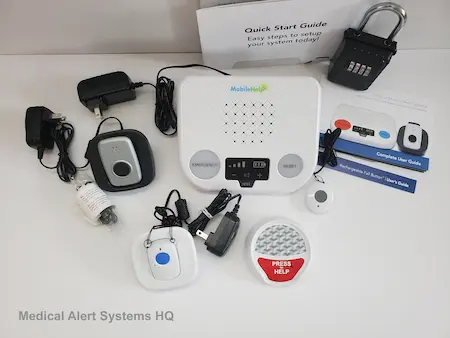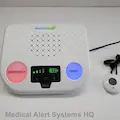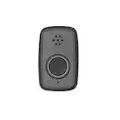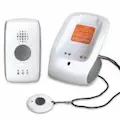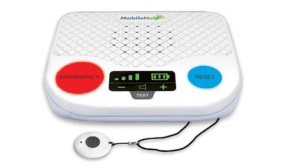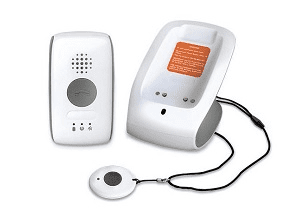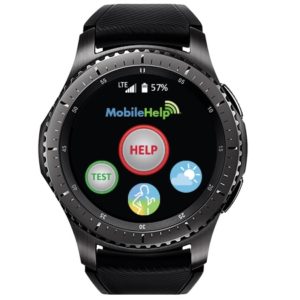Last Updated on July 5, 2023
The MobileHelp medical alert system product line offers several quality options for consumers. Its in-home and out-of-home Duo system combines the reliability of a home base station unit with the portability of a mobile device unit. Their equipment provides users access to 24/7 personal emergencies response monitoring both in and out of their homes. A home phone line is not needed. MobileHelp’s mobile alert GPS device offers convenient location tracking.
All MobileHelp medical alert systems include access to the MobileHelp Connect online portal or app for family members and caregivers. MobileHelp Connect allows authorized family members and caregivers to retrieve GPS location data and receive email and/or text notifications of system status updates and whenever emergency alerts have been activated.
In the video below, I demonstrate how the MobileHelp in-home cellular system, Classic, works by pressing on the necklace button. Upon a button press, you can see how the base unit immediately announced “Call in progress.” Further in this review, I will be demonstrating the mobile MD5 Micro device (portable and small).
Pros
In & Out Of The Home Use – MobileHelp’s Duo and Solo systems allow the senior user to be protected both in and out of their homes. Customers who just want in-home protection can choose their Classic system.
In-home No Landline Offer – MobileHelp Classic is an industry recognized In-home No-landline-needed system. It is popularly rebranded and sold wholesale to companies. Customers can save by buying direct from MobileHelp, the medical alert technologies provider.
MobileHelp Connect Alerts – Every MobileHelp system comes with MobileHelp Connect. This allows authorized family members and caregivers to set up email and/or text alerts whenever the emergency button has been pushed and when there are system status updates. Mobile GPS location data can also be accessed through this secure platform.
No Home Phone Line Needed – Almost all MobileHelp medical alert systems, whether for in-home use or mobile, work through their built-in cellular network connections. No home phone line or cell phone subscription is needed.
No Long Term Contracts – MobileHelp does not tie their customers into long term contracts.
Cons
Response Time variation – When testing MobileHelp, we measured varying response times. At times, a monitoring operator answered within 30 to 60 seconds, which is about average for the industry. At other times, it took longer to connect with an operator. On average, we received a response time of over 1.5 minutes. (For more comparisons, we received faster response times with Bay Alarm Medical and Medical Guardian.)
Good AT&T Wireless Reception Needed – The home and mobile alert devices work off the AT&T cellular network.
MobileHelp Detailed Review
Background
MobileHelp is a technology leader in the medical alarms and health management solutions marketplace. They are an FDA registered company that designs and manufactures their own medical alert equipment. MobileHelp operates out of the innovation hub of Research Park at Florida Atlantic University in Boca Raton, FL.
MobileHelp’s flagship Duo mobile alert system was launched back in Nov 2009. It was one of the first mobile GPS medical alert systems to hit the market, and continues to be market-relevant till this day. The Duo’s thoughtful design of having both an in-home console unit and portable mobile extension makes this personal emergency response system product a very dependable system. It has undergone some design upgrades over time but the basic design concept remains intact and sound.
As a medical alert technologies provider, MobileHelp manufactured in-home cellular console units and portable alert devices are sold through other medical alert companies. You may have seen similar looking medical alert console units labelled with different brand names. Although the front-end box or device may look the same to customers, the purchased solutions will differ company to company. There will be differences in customization of features, monitoring services, customer support, cost, billing terms and more.
Besides being a technology provider for mobile personal emergency response systems (MPERS), the company differentiates itself through its research and development of health-related data monitoring technologies.
At the Consumer Electronics Show (CES) 2017, the company unveiled MobileVitals, a service that offers additional monitoring options for subscribers of their cellular medical alert console unit. These include blood pressure, weight and heart rate measurements.
At CES 2018, the company announced that it was collaborating with Samsung to develop the MobileHelp Smart, a smart watch that includes an emergencies help button, speaker and GPS. It will also track health statistics like heart rate, sleep and steps.
The smartwatch was expected to appeal to seniors wanting a convenient wearable emergency response button; and people who are susceptible to health emergencies, as well as people who exercise or work in potentially dangerous environments. However, the product might have been a little ahead of its time. It was later superseded by newer medical alert smartwatches from Bay Alarm Medical and Medical Guardian.
How It Works
MobileHelp currently offers 4 main medical alert systems to choose from: MobileHelp Classic, MobileHelp Micro and Mobile Solo systems, and the MobileHelp Duo system. All three are cellular based systems – connection of emergency calls are made through a cellular network phone connection. No home phone line is required for any MobileHelp medical alert system to work.
MobileHelp Classic
MobileHelp Classic consists of the cellular in-home base station unit, like the in-home unit of the Duo. It does not include the portable alert device that comes with the Duo system for on-the-go use. The system is dedicated for in-home use only. When the medical alert necklace or wrist button is pressed, it activates an alarm call through the in-home base station unit.
Monitoring Response Times
Based on our testing, the MobileHelp Classic in-home cellular system delivered a wide range of response times, ranging from a low of 25 seconds to a high of more than 2.5 minutes. This is the timing between pushing the help button and getting a live operator response.
Overall, the MobileHelp Classic system’s average response time was 1 min 37 seconds. This is slower than the overall average response time of 46 seconds, measured across 11 different medical alert products (Medical Alert Systems HQ 2021/22).
MobileHelp Micro
MobileHelp Micro, MD5, is a small all inclusive mobile GPS device that works both in and out of the home. It operates in a standalone manner without the need to pair it with a base unit or transmitter button.
In the video below, I performed a test call on the device. Once I pushed on the help button, the built-in speaker immediately announced “call in progress.” You can see the call process demonstrated in this video:
The water-resistant device houses a help button, an internal speaker, microphone, and optional fall sensing. MobileHelp provides a detachable lanyard for wearing the button device. An optional Micro case accessory is available for purchase.
The photo below shows the size of the Micro or MD5. Next to it, we’ve placed common items like a key fob and quarter coin. The measurements are shared below.
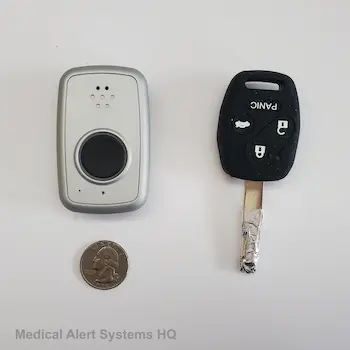
Introduced in 2021, the Micro mobile device incorporates several improvements over MobileHelp’s Solo (MD4) portable device. Both Micro and Solo are designed and manufactured by MobileHelp. The Micro presents these improvements:
- The Micro measures 2.7″ by 1.7″ by 0.6″. It is about one-fifth (1/5) or 20% smaller than the smallest Solo, MobileHelp’s previous generation portable device.
- The Micro weighs 1.8 oz, compared to the Solo’s 2.8 oz. It’s an ounce or over 30% lighter.
- The Micro has internal fall sensors (fall detection is optional – can be turned ON or OFF). With the Solo, you need to pair it with a separate fall detection button.
We experienced satisfactory to good results testing the Micro device. Upon pushing on the button, it immediately announced “call-in-progress” and a red circle formed around the button. These audio and visual signals make it very clear that the device is working. We demonstrate how the call process unfolds in video above (where we push on the button).
Monitoring Response Times
In terms of drawbacks, I found that its response times were on the slower side. MobileHelp’s Micro (MD5) response times ranged from 33 seconds to 4.75 minutes, and averaged 93 seconds. If the outlier response of 4.75 minutes was excluded, the average response time would drop to 54 seconds.
As a comparison, MobileHelp Micro’s average response timings are a little slower than the overall average timing of 46 seconds measured across 11 products from 6 top brands (Medical Alert Systems HQ 2021/22).
Backup Battery Life
The battery life at up to 72 hours is decent for a mobile device. This time frame tested true for us. This is a good thing. Some medical alert products perform less well than their advertised promises.
In my experience, after using Micro device for about two days (starting from a full charge), the low battery alerts start coming on. There are audio, email and text alerts. I like that MobileHelp provided these repeated alerts for safety reasons. However, I would still prefer to have a unit with a longer battery life between each recharge.
If I were to depend on the Micro as my main medical alert device, I would make sure to charge it daily, much like with my cell phone. If I were to use the Micro device as part of a Duo package, I would feel more reassured. That’s because I can always depend on a separate desktop in-home base unit when I am at home.
For a standalone mobile medical alert device, I would recommend comparing the MobieHelp MD5 device to the LifeFone VIPx or Mini Guardian for the following reasons. Both of these delivered faster response times and better battery life when I tested them. Size and appearance-wise, I found them to be sleeker and lighter, and therefore more conducive to use as a standalone medical alert device.
Felt Safe Carrying Device
Despite the drawbacks, I felt safe having the Micro medical alert device on me. It always connected me to a monitoring operator each time I pushed on the button. I appreciated the indicator lights that made comprehending the device easy. In addition, the Micro felt well-constructed and worked flawlessly even after wetting it under a shower.
MobileHelp Solo
The Solo system, MD4, is the MobileHelp’s older portable on-the-go device with GPS portable unit. It is similar to the Micro reviewed above. The Solo portable mobile alert unit works both in and out of the home.
While the Solo is not as small as the Micro, it has the capability of working with ultra-lightweight transmitter buttons. Senior customers have the option to wear a separate lightweight medical alert transmitter button. When needed, they can push on the transmitter button to activate an alarm call.
When going out, the portable unit can be taken out along with them. There is an emergency button right on the portable unit. Alternatively, the unit can be placed in a purse or bag, and customers can wear their medical alert button or wrist bracelet.
To compare this to other mobile medical alert systems, check out our Mobile Medical Alert Systems with GPS Reviews section.
MobileHelp Duo (When At Home)
MobileHelp Duo is combination system that includes both a Classic base unit and button, and a portable, on-the-go device like the Micro or Solo. The system works both in the home and outside. The senior customer would wear a bracelet or neck help button pendant while at home.
By pressing the help button, a call to the monitoring center would be made, connecting the senior customer who needs help with a trained monitoring center professional. They can communicate with each other through the speakerphone of the base station unit. The call connection is made through a cellular phone network.
When at home, the Duo provides a wider voice range than the Classic since you have two speaker devices. There’s a speakerphone in the Classic in-home base unit, and another speakerphone on the portable unit.
MobileHelp Duo (When Out Of Home)
When out of the home, the senior user would carry a portable wireless medical alert device like the Micro or Solo described above. These devices incorporate the emergency help button, a cell phone connection, GPS tracking and a speakerphone. It can be thought of as a handheld “base station” unit. By pressing on the help button, a call to the monitoring center will be made. The user can also wear the same at-home bracelet or pendant and press the emergency help button on these accessories to issue an alarm call through the portable alert device.
The GPS tracker on the portable medical alert device will allow the senior user’s location to be visible the monitoring center professional. Additionally, there is the online MobileHelp Connect portal that allows authorized users such as loved ones and caregivers to retrieve GPS location data for the mobile alert device.
MobileHelp Smart
Update: The MobileHelp is currently unavailable. Check out these alternatives: Bay Alarm Medical SOS Smartwatch and Medical Guardian’s MG Move.
In addition to MobileHelp’s internally developed medical alert systems listed above, the company has also teamed up with Samsung to create a medical alert smartwatch. It is modified from the Samsung Gear S3 Frontier, which has an extremely tough and durable exterior. For people who prefer having a medical alert button in the form of something well-designed and discreet, this smartwatch medical alert is worth checking out.
Besides the emergency button and monitoring functions, the watch also keeps track of various health metrics like heart rate, blood pressure, calories burned and more. To learn more, check out the full MobileHelp Smart review.
Which MobileHelp System Should You Choose?
Only In-Home Coverage Needed
If you or your parents are primarily looking for coverage at home, MobileHelp Classic would be the no-frills solution. It is also the most economical.
If you require an in-home system that does not require a home phone line, the MobileHelp Classic system compares well with similar in-home systems offered by other companies. They do not charge a premium for it. Most companies offer a standard in-home system that will require a landline to work, charging an upgrade fee if customers want that extra cellular “no home line” connection.
You could also consider MobileHelp Micro, as that gives you the additional option to bring the micro emergency communicator device along when you leave home. With this, the medical alert system is not just restricted to in-home use.
In addition, customers can take their Micro mobile unit with them when they go to the basement or attic. Some customers like the assurance that they can listen and speak through a portable unit that they can bring along with them to the more obscure parts of home.
Both In-Home And Out-Of-Home Coverage Needed
If you or your parents need coverage both in and out of the home, either the Solo or the Duo system will work. Compared to the MobileHelp Solo, the Duo system is more elaborate as it includes an additional in-home base station unit. With two separate emergency call connecting units, the Duo offers additional operational reliability. If the portable speaker unit is unintentionally left out of the charging cradle and runs out of power after a day, you can still rely on the in-home cellular base station that is always plugged in to a power source.
The Duo’s two speaker and mic units extend the voice reach of the system when at home. You can place the speaker and mic units in two areas of the home. You also have the flexibility to take the portable speaker unit along with you when going out to the yard, basement or attic. For very large homes, the Duo is well worth considering.
The disadvantage with the Duo compared to Solo is that there is additional equipment to handle. Some customers just prefer the simplicity of the Solo – having one single speaker/mic device that is also portable. The Duo is also more costly compared to the Solo by about $4 a month.
You can compare how MobileHelp’s products work versus other medical alert systems in our Reviews section. To learn more about the various types of mobile alert systems and devices, check out our guide here: 3 Main Types of Mobile Alert Systems and Devices Explained.
Cost
The cost of the MobileHelp Cellular Duo system which includes devices for both at-home and out-of-home coverage is $41.95 a month. The Solo system costs $37.95 a month. MobileHelp also sells a home use only (no mobile device) Cellular Classic package that costs $29.95 a month. Each system comes included with MobileHelp Connect, an online caregiver and alerts notification tool, for free.
The cost of a medical alert subscription also includes use of the equipment, help buttons and cell phone network services for making emergency alert calls. Customers do not need to subscribe and pay for a landline or cell phone service in order to use any of Mobile Help’s medical alert systems.
MobileHelp’s systems are competitively priced compared to other medical alert companies. Their basic in-home cellular system costs about $30 a month, less than what a similar Life Alert cellular system would cost. Their most expensive system, the Duo, costs $41.95 a month. The price tag may seem high at first, but it’s actually a reasonable price when you consider that this is a two-in-one combination package. The Duo combo system includes two separate speaker units, one of which is designed for mobile use and has GPS.
The company offers one-time promotional discounts when new customers sign-up for quarterly, semi-annual or annual billing. Savings can range anywhere from $10 to $50 for the first bill, depending on the plan you choose. After the first bill, regular retail rates apply. There are also additional options to consider.
An optional fall detection button costs $10 a month. Other additional optional services include extra GPS location pings, medication reminders, activity tracking, MobileHelp Connect premium and more.
Prices and offers are subject to change with time, so please request for their latest brochure directly if you are interested. Some specials are not published, but you can call in to access them.
Contract
There are no long term contracts or cancellation fees. In addition, the company offers a risk free 30 day trial period.
Prepaid fees for months unused will be refunded in a prorated manner. To complete a cancellation, customers must return their equipment and accessories back to the company. Like other medical alert companies, MobileHelp will only process a refund upon receipt of all outstanding items in good condition.
Equipment Overview
The home plus mobile cellular medical alert system, MobileHelp Duo, has 3 main pieces of equipment: home base station unit, portable mobile device and bracelet and/or necklace emergency button pendants.
It’s two other products, the MobileHelp Classic and the Solo are pared down versions of their flagship Duo system. The Classic system includes the home base station but not the portable device. The Solo includes the portable device but not the home base station unit. All systems come with bracelet or necklace emergency button pendants.
According to the MobileHelp, their systems comply with FDA good manufacturing standards, and meets UL standards related to the “operation and safety of digital alarm communicator system units.” This provides assurance to the user that they offer quality system equipment that works well.
Home Base Station Unit
The home base station is similar to the base stations of regular home medical alert systems. The main difference is that alarm call connections are made through a cellular phone network. This cellular connection is built into the system.
Mobile Cellular Portable Device
Their mobile cellular device is small and portable. It works just like the home base station described and has the additional feature of GPS tracking. The mobile alert device is portable and meant to be carried by the senior when they are out and about. The company provides a carrying case for it.
It works as a standalone mobile unit, or together with the bracelet or necklace emergency button pendants (ie. the emergency buttons can activate an alarm call through the wireless mobile device). The mobile device is water-resistant.
MobileHelp Button Pendants
The bracelet or necklace emergency alert buttons are waterproof and can be worn in showers and baths. They also have a battery life of up to 5 years.
These emergency alert buttons do not include a speaker and microphone. They will send a wireless signal to the base station unit or portable mobile device to initiate a call.
Automatic Fall Detection Button
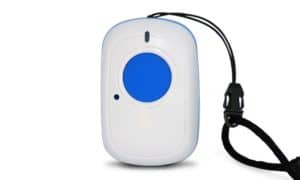
For a small monthly fee, Mobile Help’s systems can be upgraded to include automatic fall detection. This involves the use of the MobileHelp fall button. Auto fall detection is especially useful if the elderly system user meets with an emergency and is unable to manually press the alarm button. It is an extra feature that helps, but user should not assume it to be 100% accurate. There will be falls that the sensing technology cannot ascertain. Whenever possible, the system user should still press their help buttons to call for help.
Accessories
Extra accessories like key storage lock boxes, wall buttons, car or wall chargers are also available through MobileHelp. They have periodic offers that include a free lockbox with an annual subscription. They can also be orderd separately. To inquire, call them at toll-free 1-800-992-0641.
AT&T Cellular Network Connection
The Mobile Help medical alert system works using AT&T’s cellular network. All alert calls are routed through AT&T.
Range & Connectivity
The system has a maximum wireless range of 600 feet between the emergency button pendants and the base station. Between the mobile device and the emergency button pendants, the range is about 350 feet.
Note that there are no range restrictions if the user is directly pushing on the emergency call button on the base station or mobile device. Range is defined as the maximum distance between the necklace or bracelet emergency button and the base station or speaker/mic device, in order for a call activation signal to still be received.
The actual working range will depend on environmental factors, such as physical obstacles or signal interference. How well the system will work is also affected by the connection to AT&T’s wireless network. We recommend users to test their systems by making test calls from outlying points in their homes, and spots that they spend a lot of time at when at home.
When outside, if the user is clicking the emergency button directly on the mobile alert device, initiating an alert call is not an issue. However, the call can only go through if the strength of AT&T’s wireless signals is good. We recommend users test out a few different scenarios to make sure the system works for them.
Monitoring Center
Mobile Help’s emergencies monitoring services are provided through 24/7 US-based monitoring centers. They work in close partnership with Rapid Response, a long-established monitoring services provider with a dedicated medical monitoring division. They have two monitoring centers, one in Syracuse, NY and another in Corona, CA.
Rapid Response is UL certified and FM approved. Their emergency response operators are certified by the Security Industry Association (SIA). According to the company, their operators participate in a six-week rigorous training program and then undergo continuing education to improve and update their skills. In 2016, Rapid Response won The Monitoring Association’s (CSAA) Central Station of the Year award.
MobileHelp Connect
MobileHelp Connect is a companion secure online dashboard or app that allows authorized caregivers and family members to receive system alerts from the medical alert system. Authorized users can pull up the GPS location of the mobile device (and by proxy locate the senior or system subscriber). They can also set up email and/or text alerts for system status notifications (eg. low battery alert) and emergency button alerts. If the subscription does not include the mobile alert device, there will be no GPS information but event notifications like instances of emergency button presses will still apply.
MobileHelp Connect is included with their 3 main systems at no extra cost (not available with their Smart watch). This feature allows concerned children, family members and caregivers to stay connected with their parent or loved one or patient in an unobtrusive manner.
Medication Reminders and Activity Tracking
Customers can add on premium features like Medication Reminders ($5/month) and Activity Tracking ($5/month) to their MobileHelp medical alert system subscription. Medication reminders are set-up through the cellular base unit. Activity Tracking requires the use of a fall alert detection button. Subscribers can then use MobileHelp Connect to set up event notifications to inform caregivers on activity related to medication reminders and activity levels.
Mobile Vitals
Besides being a provider of personal emergency response services, MobileHelp’s MobileVitals service is helping their senior customers track and manage their health everyday. The Mobile Vitals service allows vital health statistics like weight, oxygen saturation, blood pressure and blood glucose to be collected and tracked over time.
These health metrics measurements are collected through the MobileHelp cellular base station unit, and then presented through the secure MobileHelp Connect dashboard. It is an add-on service to either a Classic or Duo subscription. The Mobile Vitals service costs $15 a month.
In addition to a monthly service fee, the MobileVitals service also requires the use of compatible bluetooth enabled appliances to measure and then beam over these vital health metrics. They include appliances like a Weight Scale, Pulse Oximeter and Blood Pressure Monitor. Mobile Vitals compatible bluetooth appliances can be purchase directly from MobileHelp.
Careful tracking of these vital statistics allow for early preventative measures to be taken, hopefully eliminating the need for customers to push their MobileHelp button down the road.
Home Base Station Backup Battery
The home base station incorporates a backup battery that lasts for about 30 hours. This keeps the system working for a while in case of a power blackout at home.
Mobile Alert Device Recharging
The mobile alert device is charged through a charging cradle. This device is meant to be placed in the charging cradle whenever the user is home. When fully charged, the portable device should have enough power to last through 24 hours on standby. An optional car charger can be purchased for on-the-go recharging.
The Mobile Help system can be configured to send out email alerts to the senior subscriber and/or caregivers whenever power on the mobile device is low and need to be recharged.
Complaints
MobileHelp has a BBB rating of A+ (as of July 2023). Its record showed 44 complaints in the last three years (since Jun 2020). All 44 complaints were earnestly addressed. Most of the complaints had to do with billing issues. One customer was dissatisfied with the monitoring response time being almost 8 minutes long (complaint dated Jan 2, 2022). The company answered the complaint promptly and provided details on their process see details).
When we tested MobileHelp’s products (Nov 21 to Jan 22), we experienced a wide variation in their monitoring response times, ranging from a fast 25 seconds to nearly 5 minutes. If you choose to go with them, do test the sytsems out for yourself to see if you are satisfied with their response times.
In summary, consider both MobileHelp’s pros and cons, compare it with other top medical alert companies to see what fits your needs best. Check out our Compare Medical Alert Systems Chart.
Need help choosing?
We can help. Contact us here. Do let us know more about what you are seeking, and if you are interested in MobileHelp or another brand. That enables us to provide you with a better response.
Disclaimer: Our reviews are based on our product experience and research. We hope that sharing our experiences help. However, we cannot guarantee that your results will be the same as ours. We advise all readers to do careful due diligence before purchasing. Whichever products you choose, be sure to test them out and make sure they work to your satisfaction.
Submit my MobileHelp feedback
If you are a Mobile Help customer, how is your experience so far? Your opinion matters to us. Thank you for being our reader.
- Bay Alarm Medical In-Home Cellular Response Speed 46% Faster in 2023 - July 5, 2023
- Medical Alert Systems For Landlines - November 20, 2022
- The Truth About Long-Range Medical Alert Systems - May 1, 2022
In a hurry? Leave us your email, we’ll follow-up with the best tips.

